Physical Address
304 North Cardinal St.
Dorchester Center, MA 02124
There is a continued rise of hepatocellular carcinoma (HCC) incidence, especially in the Western hemisphere.
HCC main risk factors are hepatitis B, hepatitis C, alcohol use, and nonalcoholic steatohepatitis.
Screening programs continue to evolve but depend mainly on ultrasound and α-fetoprotein (AFP) evaluations.
Staging of HCC depends on evaluating the two aspects of the disease: the cancer itself and the commonly associated cirrhosis.
Pathologic evaluation may help distinguish variants or combined HCC and cholangiocarcinoma.
Patterns of spread are hematogenous and may involve lung and bones.
Surgery, liver transplantation, and radiofrequency ablation (RFA) are the sole proven curative therapies for HCC.
Locally advanced disease is generally treated with different forms of local therapies, including but not limited to transarterial embolization, chemoembolization, radioembolization, and radiation therapy.
Sorafenib and lenvatinib both have been shown to improve survival in the first-line setting; regorafenib has been shown to improve survival in the second-line setting.
Future developments are dependent on progress in immunotherapy, discovery of potential new targets, and combination of therapies of different modalities.
Future studies are most likely to entail enriched patient populations based on biology, risk factors, and/or etiology.
The majority of biliary tumors are adenocarcinomas.
Biliary tumors have been classically understood as three different diseases—gallbladder cancer and extrahepatic and intrahepatic biliary tumors—with different clinical and biologic characteristics. A novel approach to differentiate the three diseases based on biology and pathways is evolving.
Gallbladder resection may require resection of segments IVa and V of the liver and locoregional lymph node dissection for better tumor control and staging.
Preoperative considerations for extrahepatic biliary tumors include percutaneous transhepatic biliary drainage.
Surgical therapy for distal extrahepatic cholangiocarcinoma is a pancreaticoduodenectomy, as for all periampullary malignancies.
Adjuvant capecitabine improved overall survival in biliary cancers when compared with placebo in a randomized trial.
The standard of care for advanced disease consists of gemcitabine plus cisplatin based on the ABC-02 study.
Hepatocellular carcinoma (HCC) is the most common of all liver cancers and is a major global public health problem. A large amount of investigational energy is focusing on optimal management of this disease, especially for the development of novel systemic therapies. Nevertheless, the only curative therapeutic modalities remain surgical resection, liver transplantation, and ablation in select cases.
HCC is the sixth most common malignancy in the world and is responsible for 600,000 deaths annually. Approximately 82% of cases arise in developing countries, with 55% in China alone, caused by hepatitis B virus (HBV). Transmission of HBV occurs both vertically and horizontally. In the United States, HCC incidence and mortality continue to rise. According to the American Cancer Society and the Surveillance, Epidemiology, and End Results (SEER) database, 39,230 new diagnoses of primary liver cancer and intrahepatic cholangiocarcinoma (ICC) and 27,170 deaths from these diseases were expected to occur in2016. Most cases of HCC in the United States are secondary to hepatitis C virus (HCV), but nonalcoholic steatohepatitis (NASH) is expected to be the leading cause in the coming decade. Southern European countries in the Mediterranean basin have a high incidence of HCC mainly due to HCV and alcohol use.
Egypt represents a particular and very concerning example in which HCC incidence continues to increase exponentially and is a leading cause of cancer morbidity and mortality. Egypt has one of the highest prevalences of HCV in the world, ranging between 6% and 40% in different regions. This is partly the result of a national treatment program against schistosomiasis, another known risk factor for HCC, in which the use of nondisposable needles potentially served as a conduit for transmission and a continuing epidemic.
Worldwide, HCC is more common among men than women, with a ratio that ranges from 1.5 : 1 to 11 : 1. The male-to-female ratio is further increased in high-risk areas. This disparity might be a consequence of the differential effects of androgens and estrogens on hepatocytes.
Temporal age variations are also noted, reflecting different patterns of exposure to etiologic factors. In high-risk areas, the age-specific incidence rates begin to increase after the age of 20 years, reflecting the importance of vertical transmission of HBV or acquisition of HBV infection in early childhood, and stabilizes at age 50 years and older. In low-risk areas, the incidence rate steadily increases with age, reflecting the later acquisition of viral infection or the impact of other factors, such as alcohol-related cirrhosis and nonalcoholic fatty liver disease (NAFLD).
Fibrolamellar carcinoma, which is considered a variant of HCC, is an extremely rare disease, comprising less than 1% of all primary liver cancers, and distinct from HCC. Fibrolamellar carcinoma occurs equally in younger individuals, with a median age of 27 years, with a slight preponderance in women and without any underlying liver disease. It also tends to occur more frequently in whites.
Several risk factors have been identified as causative agents for HCC. Although most patients will carry one risk factor, all agents have been reported to act synergistically as in the case of hepatitis, alcohol, and diabetes.
Viral hepatitides, mainly HBV and HCV, are the leading risk factors for HCC in Asian and Western populations, respectively. HBV is a DNA virus that can disrupt key regulatory oncogenes of the host genome by insertional mutagenesis. Chronic inflammation because of the host immune response may also destabilize the genome, permitting the accumulation of transforming mutations leading to HCC. HBV vaccination has been introduced nationwide in many countries and should be available worldwide to prevent this endemic infection and decrease the incidence of HBV-related HCC. In the case of HCV, an RNA virus, hepatocarcinogenesis is driven by oxidative DNA damage and inflammation, which give rise to cirrhosis and eventually HCC in a process that may take 10 to 30 years in 5% of those patients who were infected with HCV at some point. There is no HCV vaccine, but advances in antiviral therapy have improved the cure to above 90%. However, cancer risk persists for years after virus eradication, and thus monitoring is crucial.
Excessive alcohol consumption is a well-recognized risk factor for HCC. Several molecular mechanisms, including oxidative stress and altered cellular metabolism, have been implicated in the development and progression of alcoholic liver disease. Hepatocarcinogenesis results from the direct hepatotoxic effects of alcohol and the development of alcoholic cirrhosis.
Morbid obesity, diabetes mellitus, and resultant NASH are all independent risk factors for hepatocarcinogenesis. The metabolic syndrome is associated with peripheral insulin resistance and upregulation of the insulin/insulin-like growth factor–1 receptor (IGF1/IGF-1R). Hereditary hemochromatosis is a common hereditary metabolic disorder in Northern European countries, with a 20- to 220-fold higher risk of developing HCC. Other metabolic disorders associated with the development of HCC include α 1 -antitrypsin deficiency.
Aflatoxin, produced by the Aspergillus fungus that contaminates grain products, is a recognized risk factor for developing HCC in sub-Saharan Africa and southeast Asia. Carcinogenesis occurs as a result of p53 tumor suppressor mutations as a consequence of the transversion of glycine (G) to threonine (T) at codon 249.
Betel quid consumption is a popular practice in several Asian countries. The major carcinogenic ingredient in betel quid is the arecoline alkaloid. Mouse models have shown that toxicity occurs through immunosuppression, structural hepatocyte injury, and suppression of antioxidants.
Contaminated water in parts of rural China with microcystins, a blue-green algal hepatotoxin, can cause HCC by increased oxidative DNA damage and induction of apoptosis by increasing expression of p53 and Bax while suppressing expression of Bcl-2.
A majority of HCC develops in patients with cirrhosis and active liver disease, and prevention of HCC is largely dependent on preventing liver disease and limiting progression to cirrhosis. Although aspirin, statins, coffee, metformin, and other compounds may play a role in HCC chemoprevention, benefits have not been shown to exceed the risks and costs.
Most national and international oncologic and hepatologic societies recommend combined-modality screening, but the evidence is not as strong, nor are the results of screening as encouraging, as they could be.
The American Association for the Study of Liver Diseases (AASLD) provides guidance on populations requiring surveillance. Patients requiring surveillance include all patients with cirrhosis and all those with chronic HBV infection. Considerable controversy exists, however, with regard to patients with other causes of liver diseases.
Among patients with HBV infection, those who should undergo surveillance include Asian men older than 40 years and women older than 50 years, patients of African heritage, and patients with a family history of HCC, regardless of treatment status. In patients with cirrhosis from other causes, HCC screening is reasonable in those who are well enough to benefit from early detection, when the estimated annual risk of HCC exceeds 1.5%. This includes patients with advanced liver disease due to HCV infection, stage 4 biliary cholangitis, hemochromatosis, and α 1 -antitrypsin deficiency. It does not include noncirrhotic HCV and NAFLD.
Although measurement of serum α-fetoprotein (AFP) has been traditionally employed as a screening test for HCC in at-risk populations, its observed effect on overall survival (OS) has been mixed across studies. In the current ASL guidelines, AFP is no longer recommended as a screening test for HCC unless other screening tests are unavailable; surveillance ultrasonography at 6-month intervals is recommended, based on observational data of expected growth rates of HCC. Cost-effectiveness analysis suggests that semiannual screening improves clinical outcomes, at a moderate cost. However, most current guidelines from Asia recommend a combination of semiannual ultrasonography and serum testing. The role of other serologic tests such as assays for osteopontin, des-γ-carboxy prothrombin, Lens culinaris agglutinin-reactive fraction (AFP-L3), IGF1, and other compounds remains unclear.
Newer radiologic techniques, such as multiphasic computed tomography (CT) and contrast-enhanced magnetic resonance imaging (MRI), including the newer gadoxetate acid–enhanced MRI, remain unclear with regard to any impact on mortality rates in at-risk populations and may have limited cost-effectiveness.
HCC is a malignant neoplasm derived from the hepatocytes. Grossly, HCCs associated with liver cirrhosis often manifest as expansile tumors with a fibrous capsule and intratumoral septa; in contrast, tumors arising in noncirrhotic livers tend to grow to massive size and may be nonencapsulated ( Fig. 77.1 ). All HCCs have a strong propensity for invasion of vascular channels, and large vein invasion may be seen grossly. Histologically, HCCs assume a wide spectrum of morphologic alterations ( Fig. 77.2 ). Well-differentiated HCCs recapitulate the cellular and architectural characteristics of benign hepatocytes to such an extent that a histologic diagnosis of malignancy can be a challenge, especially in small biopsy samples. On the other hand, poorly differentiated tumors may lose almost all histologic hallmarks of hepatocytes. A variety of histologic patterns have been described, including trabecular, acinar, solid, and scirrhous. The prognostic significance of these patterns, however, is yet to be determined.
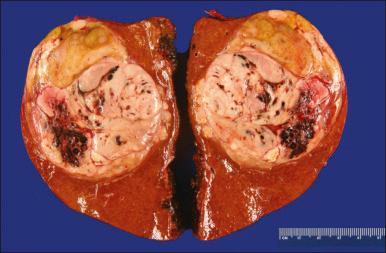
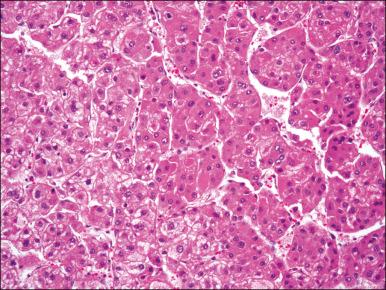
Approximately 5% of all primary liver tumors are combined hepatocellular-cholangiocarcinoma. The World Health Organization (WHO) defines such tumors as having unequivocal, intimately mixed elements of both HCC and cholangiocarcinoma. Histologic or immunophenotypic evidence of hepatocellular and glandular differentiation is needed for the diagnosis. A distinctive clinicopathologic variant of HCC is the fibrolamellar carcinoma, which occurs in young adults and has no association with cirrhosis or other known risk factors. This variant tends to present as well-circumscribed, nodular, yellow-to-brown tumors with extensive fibrosis grossly. Some tumors may present with a “central scar.” Histologically, this variant is characterized by the presence of dense bands of lamellar fibrous tissue separating the tumor cells, which are typically polygonal and exhibit large nuclei with prominent nucleoli ( Fig. 77.3 ).
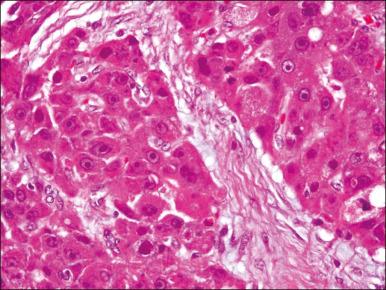
Hepatoblastomas also have distinct histologic patterns. These tumors are characterized by various combinations of several epithelial and mesenchymal cell lineages, with the epithelial lineages recapitulating early hepatic oncogenesis, including immature hepatoblasts and mature hepatocyte-like cells. They occur primarily in the pediatric population, with approximately 70% occurring in the first 2 years of life. About one-third of hepatoblastomas belong to the subtype named fetal epithelial hepatoblastoma. In this subtype the tumor cells resemble hepatocytes of the developing fetal liver. Other subtypes have more varied histologic characteristics, and a detailed description is beyond the scope of this chapter.
Immunohistochemical studies may aid in the diagnosis of hepatocellular neoplasms. Characteristic hepatocellular markers include arginase 1, a binuclear manganese metalloenzyme that catalyzes the hydrolysis of arginine to ornithine and urea; the hepatocyte antibody, also known as HepPar-1; glypican-3, an oncofetal protein elevated in the sera of many patients with HCC; polyclonal carcinoembryonic antigen (CEA); and CD10. AFP can also be positive in 30% to 50% of HCCs, and its staining tends to be focal. Fibrolamellar carcinomas tend to express CK7 and epithelial membrane antigen, two markers that are typically not expressed in conventional HCC, which can help to differentiate between fibrolamellar carcinoma and HCC.
HCC characteristically invades the portal vein and its branches, and vascular invasion is the main route for intrahepatic tumor spread. Tumor invasion into the major bile ducts is infrequent clinically but may be seen histologically. Intraorgan spread of HCC is considered under the T category, not M, in the American Joint Committee on Cancer (AJCC) TNM staging system. Extrahepatic tumor spread is common; it occurs mainly via hematogenous dissemination and targets the lung most commonly, followed by bone and other sites such as the adrenal glands. In recent years, bone metastases from HCC have increased in incidence. This increasing potential for metastatic disease is mainly explained by the improved survival of HCC patients across the board. It is thus imperative that patients with HCC receive appropriate staging that includes a whole-body radiologic evaluation including the chest. Bone scans should be done in case of symptoms or suspicious radiologic or laboratory findings.
Lymph node metastasis is more commonly seen in fibrolamellar carcinoma. In a retrospective analysis of 95 cases of fibrolamellar carcinoma from three institutions, lymph node metastases were present in 50% of the cases.
Although a majority of patients have locoregional disease at initial presentation, many patients have stage IV disease or develop metastases at a later time. Recurrences after surgery are either intrahepatic or extrahepatic, with the most common sites of extrahepatic metastasis being lung, retroperitoneal lymph nodes, and bone. Clinical manifestations include malaise, anorexia, abdominal pain, abdominal fullness due to ascites or mass effect, and/or weight loss. Acute abdominal pain and distention caused by the spontaneous rupture of a superficial tumor with resulting hemoperitoneum is a common presentation of HCC in high-prevalence areas. This potentially fatal event is a medical emergency that warrants early recognition and management.
Because a majority of cases of HCC occur in patients with underlying cirrhosis, any worsening of hepatic function in a patient with previously diagnosed cirrhosis must prompt an evaluation for occult HCC.
All patients with suspected HCC should undergo hepatitis serologic studies, which include testing for hepatitis B surface antigen, hepatitis B core antibody, and hepatitis C antibody. Patients should also be evaluated for other risk factors for developing HCC. Where applicable, a polymerase chain reaction quantitative assay should be performed. An assessment of liver function and cirrhosis should be performed; the most commonly used assessment tool with widespread availability is the Child-Pugh score ( Table 77.1 ). Although there are guidelines to help diagnose HCC with imaging and AFP levels, these are applicable for screening and surveillance situations. Their application, of course, will depend on a faithful application of the criteria, which include a diagnosis of cirrhosis (which remains ill defined). Newer technology may help improve the noninvasive diagnosis of HCC. Gadoxetate disodium is a new gadolinium-based contrast agent indicated for intravenous use in T1-weighted MRI of the liver to detect and characterize lesions in adults with known or suspected focal liver disease. Cholangiocarcinoma is commonly identified in what was thought to be HCC.
| Criterion | 1 Point | 2 Points | 3 Points |
|---|---|---|---|
| Bilirubin | ≤2 | 2–3 | >3 |
| Albumin | >3.5 | 2.8–3.5 | <2.8 |
| INR | <1.7 | 1.7–2.2 | >2.2 |
| Ascites | None | Mild | Moderate |
| Encephalopathy | None | Mild | Moderate |
In the setting of advanced disease, and especially if systemic therapy is considered, a biopsy is very valuable. As described in the pathology section, diagnosis of HCC may include variants and possible combined cholangiocarcinoma plus HCC, the treatment of which will differ from that of HCC. Translational research with tissue specimens has been pivotal in the elucidation of key signaling pathways that may be targeted with novel therapies. Liver biopsy is a comparatively safe and well-tolerated procedure. Although it is true that it carries a risk of bleeding and tumor seeding, these complications are rare, with hemorrhage reported in 0.4% of cases and tumor seeding in 1.6% of cases.
Dynamic CT has replaced ultrasonography in assessing HCC. In the early phase the tumor is hyperdense because of its increased vascularity ( Fig. 77.4 ). In the later phase, the tumor is hypodense, as a result of washout of contrast from the more “porous” lesion. On MRI, HCC is of low signal intensity on T1-weighted images and of intermediate signal intensity on T2-weighted images. Because of the propensity of this tumor for extension into and along major vessels, contrast-enhanced triple-phase CT or MRI is particularly useful for imaging the portal and hepatic veins. In addition, contrast-enhanced images provide critical information about multifocality, resectability, and presence of extrahepatic disease.
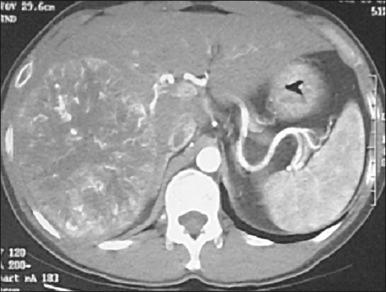
Although positron emission tomography with fluorine-18–labeled fluorodeoxyglucose ( 18 FDG) has been found to be useful for imaging a variety of tumors, its use in HCC has yielded disappointing results, with significantly lower standardized uptake values for HCC compared with metastatic tumors or other primary liver tumors.
The seventh edition of the AJCC staging classification uses size, presence of vascular invasion, lymph node status, and metastatic disease as prognosticators of outcome ( Table 77.2 ). The main features of this revised system included a separate staging system for HCC and ICC, a split of the T3 category to reflect the different prognoses of large multifocal lesions versus the presence of macrovascular invasion, a redefined N1 category, and a classification of lymph node metastases as stage IV disease. The most recent version of the AJCC system from 2017 contains some significant changes in the primary tumor (T) classification relative to the 2010 version. T1 is now subdivided into two subcategories: T1a (solitary tumors ≤2 cm) and T1b (solitary tumors without vascular invasion >2 cm). T2 now includes a solitary tumor with vascular invasion greater than 2 cm, or multiple tumors, none greater than 5 cm. The previous T3a category (patients with multiple tumors, any of which are >5 cm) is now recategorized as T3, whereas tumors that were previously considered T3b (single or multiple tumors of any size that involve a major portal vein or hepatic vein) are now T4, as are tumors with direct invasion of adjacent organs other than the gallbladder or with perforation of the visceral peritoneum.
| Stage | Grouping | ||
|---|---|---|---|
| 0 | Tis | N0 | M0 |
| I | T1 | N0 | M0 |
| II | T2 | N0 | M0 |
| III | T3 | N0 | M0 |
| IVA | T4 Any T |
N0 N1 |
M0 M0 |
| IVB | Any T | Any N | M0 |
| DEFINITIONS | |||
| Primary Tumor (T) | |||
| TX | Primary tumor cannot be assessed | ||
| T0 | No evidence of primary tumor | ||
| Tis | Carcinoma in situ (intraductal tumor) | ||
| T1 | Solitary tumor without vascular invasion | ||
| T2a | Solitary tumor with vascular invasion | ||
| T2b | Multiple tumors, with or without vascular invasion | ||
| T3 | Tumor perforating the visceral peritoneum or involving the local extrahepatic structures by direct invasion | ||
| T4 | Tumor with periductal invasion | ||
| Regional Lymph Nodes (N) | |||
| NX | Regional lymph nodes cannot be assessed | ||
| N0 | No regional lymph node metastasis | ||
| N1 | Regional lymph node metastasis | ||
| Distant Metastasis (M) | |||
| M0 | No distant metastasis | ||
| M1 | Distant metastasis | ||
The prognosis of HCC depends not only on an anatomic assessment of the tumor, but also on the extent of underlying liver cirrhosis. The Child-Pugh scoring system remains the most commonly used tool for assessing cirrhosis. It is the most common scoring system used in HCC clinical trials. It consists of five parameters: serum bilirubin, serum albumin, prothrombin time, clinical ascites, and clinical encephalopathy. The severity of each parameter is graded from 1 to 3 (see Table 77.1 ), and the total makes up the score that is defined as A to C.
The limitations of both the TNM and Child-Pugh systems was first overcome by the Okuda staging system, which includes parameters related to the cirrhosis and factors related to the cancer itself. The Okuda scoring system was considered by many as unsatisfactory, and several scoring systems followed, many of which were prospectively validated. These include, but are not limited to, the Cancer of the Liver Italian Program (CLIP), the Chinese University Prognostic Index (CUPI) scoring system, the Groupe d'Étude et de Traitement du Carcinome Hépatocellulaire (GETCH) staging system, the Japan Integrated Staging (JIS) system, and the Barcelona Clinic Liver Cancer (BCLC) classification system. The BCLC system couples prognosis with treatment assignment; however, it has been found to be less valuable in the setting of more advanced disease, defined as BCLC category C. It was found that the CLIP ( Table 77.3 ), CUPI, and GETCH scoring systems were the most informative regarding outcomes in this specific patient population, whereas the BCLC classification system had limited discriminatory abilities in this population, and its use is not recommended for patients with advanced disease.
| Variables | 0 Points | 1 Point | 2 Points |
|---|---|---|---|
| Child-Pugh class | A | B | C |
| Tumor morphology | Single nodule and <50% area | Multiple nodules | Massive or >50% area |
| α-Fetoprotein, ng/mL | <400 | ≥400 | |
| Portal vein thrombosis | No | Yes |
There are continued attempts to improve on the current scoring systems and others continue to be developed. It seems unlikely that there will be a universal scoring system, especially as HCC continues to be subdivided into subtypes based on risk factors and molecular profiles.
Surgical excision by partial or total hepatectomy is the most effective and the only potentially curative therapy for HCC. Resectability for any hepatic tumor, including HCC, is dependent on several factors: the patient's ability to undergo a major surgical intervention based on general health criteria, absence of extrahepatic disease, liver disease extent, and favorable anatomic criteria—that is, the ability to achieve a complete resection while leaving behind an adequate liver remnant. Survival after liver resection depends on timely regeneration of the remaining liver, which, in turn, is influenced greatly by the preoperative liver functional status. Underlying hepatic parenchymal disease, specifically fibrosis and cirrhosis, adversely influences surgical outcome in many ways and often is the only determinant that precludes resection. The very hard nature of the liver substance in cirrhosis makes transection of the parenchyma and control of intrahepatic vessels more hazardous than in normal liver and more prone to hemorrhage. More important, the pathophysiologic changes related to portal hypertension, including the development of collateral venous channels and portasystemic shunts or varices, ascites, and hypersplenism, represents an enormous risk for perioperative hemorrhagic events and hepatic failure because of limited regenerative capacity. Portal hypertension, even in the face of relatively well-preserved hepatic synthetic function, is an ominous finding and generally excludes resection as a treatment option. For these reasons, patients with cirrhosis and HCC typically are better served with transplantation if indications regarding tumor size and number are present.
In patients with limited disease and no underlying liver parenchymal disease, the outcomes after resection are good. The operation can be performed with an operative mortality rate of less than 5% in high-volume centers, and 5-year survival may exceed 30%. This subgroup represents, however, a small minority of all patients with HCC; the vast majority have at least some degree of underlying liver disease or frank cirrhosis. The adverse influence of cirrhosis on surgical outcome is well documented, with very high perioperative mortality rates in prior series, up to 10% in some series from high-volume centers. From the same series, cirrhotic patients who survive the operation may have a reasonable 5-year survival rate, approximately 30%. Recent series have shown further improvements in outcome, with perioperative mortality of 1.4% and a 5-year survival rate of 77%. Patients with underlying liver disease who undergo resection are at high risk for recurrent disease, and also the development of new sites of malignancy in the diseased liver remnant and deterioration of liver function resulting in hepatic failure. Indeed, the presence or extent of cirrhosis has been shown to be an independent predictor of reduced survival.
Thus when assessing patients for surgery, careful evaluation of the hepatic functional reserve is equally as important as the disease extent and feasibility of a complete resection. The single most reliable method of assessing hepatic function is the Child-Pugh classification (see Table 77.1 ), which remains the most useful and most widely used in Western series, although the indocyanine green retention rate is commonly used in Asia. A more sensitive assessment of hepatic function is the hepatic vein wedge pressure, a technique that may be particularly useful for identifying patients with Child-Pugh A cirrhosis with occult portal hypertension. The invasive nature and special radiologic expertise required for this study have limited its use.
Most surgeons will consider resection only for patients with Child-Pugh A cirrhosis and in selected patients in the Child-Pugh B category, with major resections considered only in the former group. Few surgeons are willing to perform hepatic resection for patients with Child-Pugh category C, considering the high operative mortality rate and poor survival based on the underlying hepatic dysfunction. Nonetheless, some studies have reported reasonable long-term survival even when a larger tumor size required extended hepatectomy, rather than more limited resection. In general, though, these patients are better served with transplantation if they meet accepted criteria.
HCC has a great propensity for vascular invasion, and the presence of tumor thrombus within the main portal vein or vena cava ( E-Fig. 77.1 and Fig. 77.5 ) is an ominous sign that in the past was considered a contraindication to resection because of the very high risk of occult disseminated disease and the low likelihood of long-term survival. However, more recent studies have suggested that reasonable long-term survival can be achieved in selected patients in the presence of vascular invasion. A review by Roayaie and colleagues confirmed reduced OS after resection of HCC with major vascular involvement, but the results were much better in patients with portal vein tumor thrombus compared with those with hepatic vein involvement.
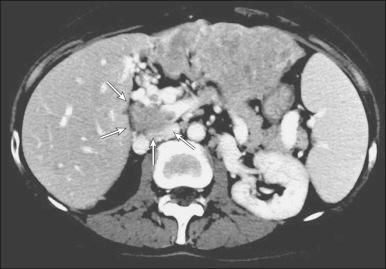
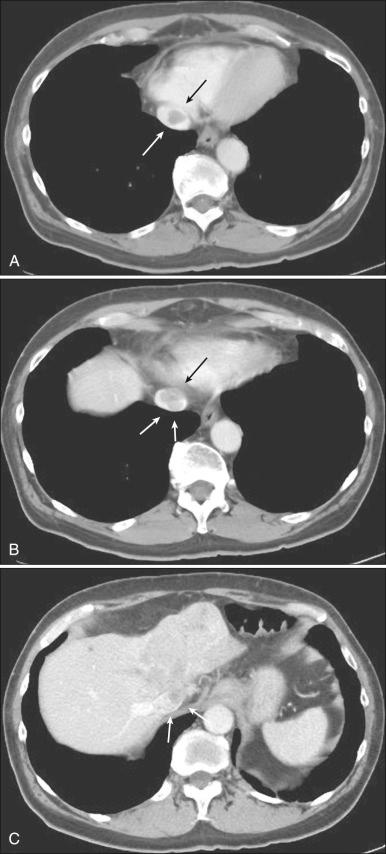
Multifocal HCC is a sign of more advanced disease but does not necessarily preclude surgical resection or ablation (or both). Five-year survival rates can be expected to be between 20% and 30%. Nonetheless, the presence of multiple tumors is associated with reduced survival after resection compared with resection of solitary tumors. Furthermore, tumor size is a well-known predictor of disease recurrence and survival.
A large analysis of 50 separate reports including nearly 15,000 patients showed a 5-year survival rate of 42%, higher in Asian than in Western patients. In a separate study from two large Asian centers, Li and colleagues reported an OS rate of approximately 40% after resection of large (≥10 cm) HCC, with worse outcome predicted with main portal vein invasion and multifocal disease. One strategy to improve outcome after resection is preoperative portal vein embolization. This technique involves occlusion of the portal vein supplying the portion of the liver targeted for resection, typically the right hemiliver. This procedure results in atrophy of the liver to be resected and hypertrophy of the future liver remnant and theoretically should result in a lower risk of postoperative liver failure. Indeed, a prospective study demonstrated the usefulness of preoperative portal vein embolization in patients undergoing resection of HCC, with significant reductions in postoperative liver failure, overall morbidity, and hospital length of stay. More recently, a technique known as ALPPS (associating liver partitioning with portal vein ligation) has been proposed to replace preoperative portal vein embolization as a means to induce rapid hypertrophy of the future liver remnant. This approach is a two-stage operation. The first stage involves dividing the liver parenchyma and the portal vein supplying the liver to be resected but leaving the specimen in situ, supplied only by hepatic arterial blood flow. In the second operation, the specimen is removed after division of the ipsilateral hepatic artery and hepatic vein, usually performed 1 to 2 weeks after the initial procedure and after ensuring adequate hypertrophy of the future liver remnant. Although ALPPS has been shown to effectively and rapidly effect hypertrophy of the future liver remnant, the high morbidity and mortality related to the procedure remain a major limitation to its widespread adoption.
The Milan criteria—single tumor less than 5 cm in size or no more than three tumors, all less than 3 cm in diameter—became the standard guidelines for hepatic transplantation in patients with hepatic cirrhosis after they were demonstrated to be associated with an actuarial 4-year survival rate of 75% after transplantation. This report refocused attention on liver transplantation for HCC, which was verified in several subsequent reports. Using these criteria, several series have found excellent 5-year survival rates of 70% or greater, with a 15% chance for recurrence.
In comparing the results of transplantation with those of resection, it is important to recognize the inherent selection bias associated with the published reports. First, most patients targeted for transplantation typically have disease that is much more limited than those undergoing resection (smaller tumors, no major vascular invasion, fewer tumors), and therefore a better prognosis. Second, there is additional selection related to selection of patients whose disease has not progressed while on the transplant waiting list. Thus the patients who receive liver transplants are those whose tumors have a less aggressive natural history. This point is demonstrated by an intention-to-treat (ITT) analysis that found “dropout from waiting list” to be the sole survival predictor. This study noted that the 2-year survival rate of patients evaluated for transplantation was reduced from 84% to 54% during two separate time periods in which the wait time increased markedly, so that more patients were excluded from transplantation as a result of progression of disease. Survival was significantly worse for patients on the transplant list than for patients who were the best candidates for resection. A more recent study found that when the waiting list time exceeded 4 months, the differences between resection and hepatic transplantation were not detectable.
The problem of the waiting list is well recognized and has resulted in a number of strategies to improve outcome, the most notable of which is the use of ablative therapy, specifically transarterial chemoembolization (TACE), for patients awaiting transplantation. Use of this strategy probably reduces dropouts from the waiting list, although its impact on long-term outcome is unclear. It is clear, however, that patients who have a response to such treatment before transplantation, even those with tumors exceeding the Milan criteria, appear to have a good prognosis. In a study from the University of California, Los Angeles (UCLA) that included 501 patients, complete pathologic response after locoregional therapy before liver transplantation was associated with lower recurrence and greater OS. In a separate study comparing resection versus transplantation in patients with disease outside of the Milan criteria, response to pretransplant downstaging with TACE was associated with significantly improved survival compared with resection or lack of response. Another factor is the advent of the Model for End-Stage Liver Disease (MELD) for assessing the likelihood of death on the waiting list, and the policy of awarding a greater number of MELD points for patients with transplantable HCC.
Transplantation yields better long-term survival figures when compared directly with resection, but such comparisons are difficult to interpret given the marked differences in patient populations. In a number of recent studies that evaluated outcomes in patients undergoing liver resection with tumors that fit the Milan criteria, the OS rates were comparable with those of transplantation. A more recent analysis comparing treatment modality only in patients with transplant-eligible disease suggested better results with transplantation, although as with all such studies, selection bias cannot be entirely eliminated as a confounding factor As expected, the risk of intrahepatic recurrence in patients undergoing resection was higher than after liver transplantation. To address this problem, a strategy of salvage transplantation in those patients whose tumor recurs after hepatectomy has evolved and may be useful, although it has been shown that not all such patients benefit from such a strategy, which may be best used in the setting of favorable histopathologic findings.
In practice, many obstacles exist to limit the applicability of transplantation to a large number of patients worldwide. The greatest obstacle is the lack of available organs for transplantation. In Asian countries, where the need for donor organs is greater, along with the social and cultural obstacles, livers are in even greater shortage than in the United States. Living donor liver transplantation has therefore emerged as a potential means of filling the gap, although its use is associated with significant donor-related morbidity and mortality and is quite controversial. Because this procedure requires a right hepatectomy in a healthy donor, concerns have arisen about the safety and ethical implications of this procedure. In addition, sporadic reports of deaths in donors have intensified these concerns. In one of the largest series reporting the results of living donor liver transplantation in 71 patients, with approximately 40% a result of HCC, the mean waiting time to transplantation was markedly reduced from 414 (for cadaveric organ transplants) to 83 days (for living related donor transplants), with a recurrence rate of 15%.
Although perioperative morbidity and mortality rates have been as high as 20%, more recent results are more favorable. In fact, a multicenter comparison of resection and transplantation showed lower 90-day mortality for the latter (4.8% for transplantation compared with 10.9% for resection). For patients with liver dysfunction, total hepatectomy with liver transplantation represents the only potentially curative option, because few of these patients can tolerate major hepatectomy. To demonstrate this point, in noncirrhotic HCC, survival is similar after hepatectomy or transplantation, whereas in patients with cirrhotic HCC, survival was significantly improved after transplantation compared with hepatectomy at each TNM stage. The cost associated with transplantation procedure is also a major obstacle.
To summarize, patients with HCC without liver dysfunction should be considered for resection, whereas patients with HCC that arises in the setting of Child-Pugh B or C cirrhosis, and with disease extent meeting the Milan criteria, should be referred for transplantation. Pretransplant response to ablative therapy is associated with improved outcome.
After resection, postoperative morbidity occurs in approximately 40% of patients, consisting primarily of transient hepatic insufficiency, intraabdominal abscess or biloma, gastrointestinal bleeding, and cardiopulmonary complications. Postoperative mortality rates range from 3% to 12% in most series. After transplantation, the 90-day mortality rate has been as high as 15% but is lower in more recent series. In the study by Adam and colleagues, operative mortality and major morbidity associated with resection and transplantation were 4.1% and 3.0%, respectively, and 19.1% and 24.7%, respectively.
After surgical treatment of HCC, scheduled follow-up evaluations are extremely important to assess for recurrence ( Fig. 77.6 ), which can occur in up to two-thirds of patients after potentially curative resection but is less common after transplantation. Many resection patients with recurrent disease actually have metachronous second primaries that develop in the setting of cirrhosis owing to the fact that the entire liver is diseased and therefore susceptible. These recurrent or new hepatomas can be treated effectively only if discovered early. It is important to emphasize that effective treatments are available for recurrent disease, including transplantation, resection, ablation, and systemic therapy.
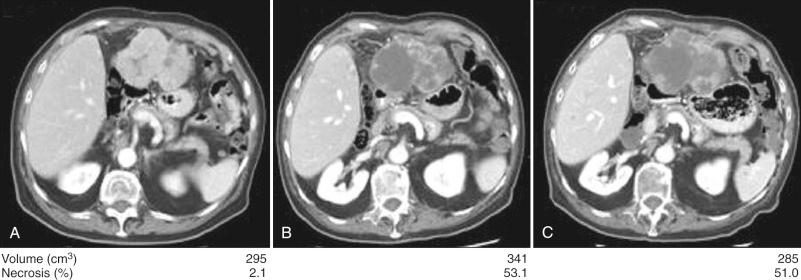
First follow-up evaluation after resection of HCC should include an office visit 2 to 3 weeks after hospital discharge. Liver transaminases and AFP are assessed. A return of tumor markers to normal levels postoperatively should dictate a routine follow-up approach of office visits every 3 to 6 months with history and physical examination and measurement of liver function tests and tumor markers. Patients should be asked about symptoms of worsening portal hypertension or liver failure and symptoms of biliary obstruction, including itching or changes in stool or urine color, primarily because a significant proportion of patients die from liver failure, not HCC. Of greatest importance is adequate treatment to prevent the complications of portal hypertension, because it is estimated that up to one-fourth of patients who die after diagnosis of liver cancer succumb to gastrointestinal bleeding from portal hypertension. New-onset right upper quadrant pain or bone pain should prompt investigation by appropriate radiologic examinations. Physical examination should evaluate for new masses, worsening ascites, and jaundice. The follow-up program also should include contrast-enhanced abdominal CT every 6 months, with a chest radiograph obtained yearly. Five years after resection, office visits should be reduced to every 6 months. The follow-up program also must aim to prevent and treat complications of associated etiologic parenchymal disease—for example, HBV and hemochromatosis.
Because recurrent HCC may be amenable to potentially curative resection, early detection of such recurrences is extremely important. Multiple series have shown that 5-year survival rates between 20% and 82% are possible in patients with recurrent HCC that is resectable. In addition, repeat liver resection can be done safely. Therefore in patients found to be medically fit for surgery, with adequate liver reserve and technically resectable tumors, repeat hepatic resection is the therapy of choice. In patients who are not candidates for repeat resection but who have isolated liver recurrence, liver transplantation may be possible. Salvage transplantation may be appropriate in selected patients with liver isolated recurrence that is within Milan criteria. In patients who are not candidates for any surgical intervention, local ablative therapies may be indicated (see later). In the report from Tabrizian and colleagues, 35% of patients with postresection recurrence were eligible for surgical therapy (repeat resection or transplantation), and in another 40% ablative therapies (radiofrequency ablation [RFA] or microwave ablation [MWA], TACE) were recommended.
Ultrasound-guided percutaneous ethanol injection therapy has largely been replaced by thermal ablation (RFA, MWA, or cryoablation) for the treatment of small (≤3 cm) HCC, based on several studies that have shown a higher rate of complete necrosis achieved with fewer treatments in the RFA group. Subsequent reports have documented equivalency in terms of OS with MWA or cryoablation. As experience has broadened, complications after ablation have become infrequent, reaching a rate as low as 2.2% after ablation of 2982 tumors in 1170 patients, with one death.
A randomized trial of RFA versus surgery for solitary HCC smaller than 5 cm found that percutaneous RFA achieved similar 4-year OS rates of 67.9% and 64%. RFA has also been used to treat patients who are listed for transplantation to avoid drop-off. For solitary HCC, ablation alone or ablation combined with embolization is likely to be as effective as surgical resection, and associated with lower morbidity as demonstrated in a retrospective case-control study, although median recurrence-free survival was longer in the surgical group.
So far no adjuvant strategy has been shown to be effective in prospective controlled studies. Retinoic acid has been shown to activate DNA repair mechanisms or induce apoptosis of hepatoma cells containing carcinogen-DNA adducts. In a prospective adjuvant trial, peretinoin prevented the occurrence of second primary HCC tumors after curative surgery or percutaneous ethanol ablation. Survival at 6 years was 74% versus 46% for the placebo group. A larger phase II/III trial of high- and low-dose peretinoin compared with placebo did not meet the primary end point of significantly improving recurrence-free survival.
A study assessing a single-dose treatment of intraarterial iodine-131–labeled lipiodol versus observation was terminated early when an interim analysis demonstrated a marked difference in survival for patients in the treatment group: 57.2 months versus 13.6 months. This approach was never carried to a larger trial in a broader patient population. Direct intraportal 5-fluorouracil (5-FU), cisplatin, and doxorubicin demonstrated an improvement in disease-free survival and OS when compared with case-matched control subjects.
Considering the angiogenic flare that starts immediately after surgery, sorafenib was evaluated in a phase III trial versus placebo; no difference in recurrence-free survival was found. Therefore its use in the adjuvant setting for HCC after resection or ablation is not recommended.
Become a Clinical Tree membership for Full access and enjoy Unlimited articles
If you are a member. Log in here